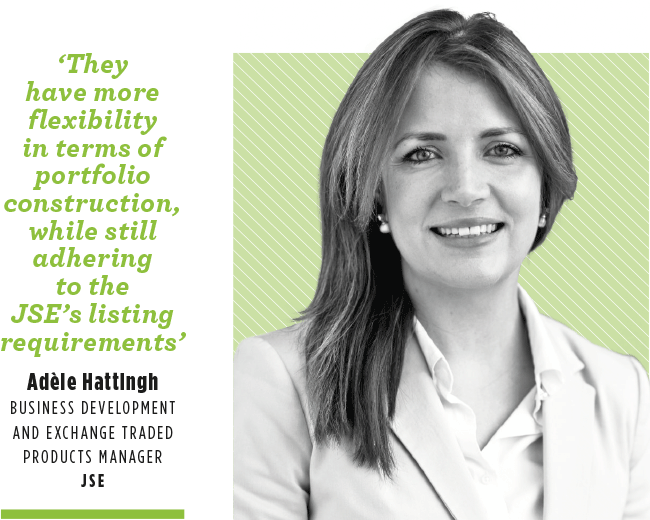These flexible and cost-effective listed investment products offer exposure to the performance of an actively managed portfolio, with the added benefit of being able to be bought and sold during trading hours. It’s no wonder, then, that actively managed certificates (AMCs) have become so popular within the global financial industry.
‘The terms of the note promise investors exposure to the performance of the investment strategy after a predetermined time of five years. However, AMCs may still be bought and sold throughout the trading day,’ says Adèle Hattingh, Primary Markets Business Development and Exchange Traded Products Manager at the JSE. ‘AMC investors therefore accept the credit risk of the issuer – which, in the South African context, would be a bank.’
While AMCs reference baskets or portfolios, they are not funds. Rather, they are viewed as debt instruments – or, in some global jurisdictions, as structured products or derivatives. Their listed nature allows for intraday trading and T+3 settlement (the intermediary’s obligation to settle trades by the third day following the trade date). The client-liability management through underlying client record-keeping, provided by the Central Securities Depository (Strate), is another benefit.
‘AMCs can offer exposure to the performance of local or global underlying assets where the portfolio is dynamically adjusted according to a particular strategy, managed by a third party,’ says Hattingh. ‘Investors therefore rely on investment professionals and not themselves to manage this strategy, while gaining the benefit of convenience and expertise in a listed product.’ AMCs allow investors to introduce or enhance an active investment strategy to their investment portfolio, she adds, which can help deliver market-beating returns as the underlying strategy aims to benefit from certain market conditions and movements.

‘Investors may opt to combine their AMCs with a passively managed product like an ETF. This would allow them to construct a portfolio that encompasses both investment strategies, while offering diversification, managing market and portfolio risk, and addressing some of the shortcomings found in either strategy.’
The JSE recently added a new set of requirements that call for AMC issuers to regularly publish an intraday reference portfolio value, or the detailed constituents of the portfolio. ‘They are also required to appoint an agent to trade on their behalf at a price derived from publicly available information, such as the reference portfolio value,’ says Hattingh. ‘Alternatively, if the detailed constituents are published on a daily basis, they must appoint an independent market maker.’ Issuers are also required to show that there are sufficient information barriers in place between themselves and the appointed agent in providing liquidity in the market.
Those new requirements cater specifically for AMCs, and are partly because the previous listing requirements did not address their unique characteristics, and partly because of their increasing popularity.
Hattingh is not surprised by the interest in AMCs. ‘Issuers are searching for a “wrapper” that will enable cost-efficient management of the underlying assets, as the third-party portfolio manager benefits from using existing bank infrastructure, such as custody and trading infrastructure services,’ she says.
‘As AMCs are not funds, they are not bound by fund-specific regulatory requirements, or by many of the costs associated with establishing a fund. This means they have more flexibility in terms of portfolio construction, while still adhering to the JSE’s listing requirements.’
At the same time, Hattingh concludes, investors are searching for a well-regulated, easily accessible, tradable and cost-effective listed instrument that offers exposure to various underlying assets. ‘This might be traditionally difficult to come by for an indi- vidual, but in the context of AMCs they are managed according to an active investment strategy by an investment professional.’








